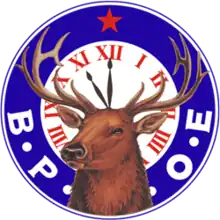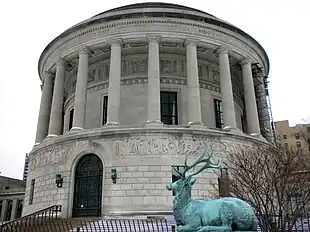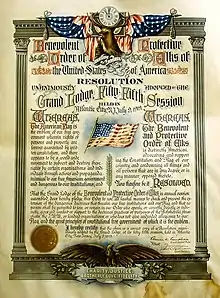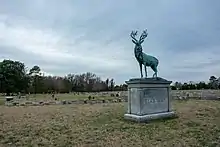Benevolent and Protective Order of Elks
The Benevolent and Protective Order of Elks (BPOE; also often known as the Elks Lodge or simply The Elks) is an American fraternal order founded in 1868, originally as a social club in New York City.
.jpg.webp)
 | |
| Abbreviation | BPOE |
|---|---|
| Founded | 1868 |
| Founder | Charles Vivian |
| 36-0793011[1] | |
| Legal status | 501(c)(8) fraternal benefit order[1] |
| Headquarters | Chicago, Illinois, United States |
| Coordinates | 41.9323°N 87.6400°W |
| Affiliations | 1,928 local lodges,[2] Elks National Home and Retirement Center, Elks National Foundation, Elks National Veterans Service Commission, Elks Veterans Memorial Restoration[1] |
| Website | www |
History
The Elks was established by actor Charles Algernon Sidney Vivian – a British expatriate and member of the Royal Antediluvian Order of Buffaloes – in New York City on February 16, 1868.[3] Organized as a club for minstrel show performers, the impetus for the group's founding was the death of a fellow actor to disease due to a paucity of funds for treatment and a desire to organize communal support for fellow actors in need.[4][5]
Founded as the "Jolly Corks", by December of 1868 it had adopted the name Benevolent and Protective Order of Elks.[3]
By 1890, 173 lodges had been established throughout the United States.[5]
In 1976, the Elks had 1,611,139 members.[6] As of June 2020, it claimed to have more than 750,000 members.[7]
Desegregation
In 1972, the Elks expelled the head of the Ridgewood lodge, Richard J. Zelenka, because of his advocacy against the Elks' discriminatory policies which limited membership to white men.[8][9] By the following year, however, a resolution to repeal the discriminatory clause of the national constitution passed, desegregating the organization.[10][11]
In Beynon v. St. George-Dixie Lodge 1743 (1993),[12] the Utah Supreme Court ruled that while freedom of association allowed the Elks to remain a men-only organization, "the Elks may not avail itself of the benefits of a liquor license and the license's concomitant state regulation" as long as it violated the Utah State Civil Rights Act. Faced with losing their liquor licenses if they did not admit women, the Elks Lodges of Utah voted to become unisex in June 1993,[13] which was followed by a vote at the Elks National Convention in July 1995[14] to remove the word "male" from the national membership requirements.
Membership
Belief in a Supreme Being became a prerequisite for membership in 1892. The word "God" was substituted for Supreme Being in 1946.[15]
In 1919, a "Flag Day resolution" was passed, barring membership to even passive sympathizers of the Bolsheviks, Anarchists, the I.W.W., or kindred organizations, or who does not give undivided allegiance to" the flag and constitution of the United States.
In 1979, the qualifications for membership included being male, at least 21 years old, of sound mind and body, a citizen of the United States and not a member of the Communist Party.
The current requirements include belief in God, American citizenship, willingness to recite the Pledge of Allegiance, willingness to salute the flag of the United States of America, willingness to support the laws and Constitution of the United States of America, being of good character and being at least 21 years of age.[7] There is also a background interview conducted by the Membership Committee, who make the final recommendation to the Lodge members. The members then use a ballot box,[16] with the back drawer first being displayed to the members to be empty, then the members drop their vote one at a time into the hole in the back, typically a white glass marble to accept or a black lead cube to reject. A 2/3 majority of member votes is necessary for acceptance.[17]
Organization
Headquarters

The Elks' national headquarters are located in Chicago at the Elks National Veterans Memorial and Headquarters, overlooking Lincoln Park, near Lake Michigan. This building was originally conceived as a memorial to the nearly 1,000 Elk brothers who were lost in World War I. The cornerstone was laid July 7, 1924, and the building was officially dedicated on July 14, 1926.[18][19]
The rotunda displays murals and statues illustrating the Elks' four cardinal virtues: charity, justice, brotherly love and fidelity. The friezes depict the "Triumphs of War" on one side and "Triumphs of Peace" on the other. The entrance is flanked by large bronze elks.[20]
Grand Lodge
The BPOE is organized on five levels: the national or "grand" level, the regional level, the state level, the district level and the local lodge level. The highest level is the Grand Lodge, which meets in convention annually. The Grand Lodge elects all the officers of the order, such as the Grand Exalted Ruler—the chief executive officer of the organization—Grand Secretary, Grand Esteemed Leading Knight, Grand Esteemed Loyal Knight, Grand Esteemed Lecturing Knight, Grand Treasurer, Grand Tiler (in charge of regalia), Grand Inner Guard and Grand Trustees. The three Knights assist the Grand Exalted Ruler and officiate in his absence; furthermore, the Grand Esteemed Loyal Knight acts a prosecutor in cases when an Elk is accused of an offense against the order. The Grand Trustee have general authority over assets and property owned by the order. The Grand Esquire is appointed by the Grand Exalted Ruler and organizes the Grand Lodges and serves as marshal of Elks parades. The Grand Chaplain is also appointed by the Grand Exalted Ruler.[21]
Elks Magazine is published 10 times a year and goes to all members.[22]
Grand Exalted Rulers
This is an incomplete list of the organization's Grand Exalted Rulers:
- 1871 – George J. Green / Charles T. White
- 1872 – Joseph C. Pinckney
- 1874 – James W. Powell / Henry P. O'Neil
- 1876 – Frank Girard
- 1878 – George R. Maguire
- 1879 – Charles E. Davies / Louis C. Waehner
- 1880 – Thomas E. Garrett
- 1882 – John J. Tindale
- 1883 – Edwin A. Perry
- 1884 – Henry S. Sanderson
- 1910 – August Herrmann (1859–1931)
- 1919 – Frank Lewis Rain (1877–1941)
- 1924 – John G. Price (1871–1930)
- 1935 – James T. Hallinan (1889–1969)
- 1959 – William S. Hawkins (1910–1971)
- 1967 – Robert E. Boney (NM)
- 1982 – Marvin M. Lewis (CA)
- 1990 – James W. Damon (OR)
- 1991 – Lester C. "Ted" Hess, Jr. (WV)
- 1992 – Vincent Collura (NE)
- 1993 – Charles F. Williams (TX)
- 1994 – Kenneth L. Moore (CA)
- 1995 – Edward Mahan (MA)
- 1996 – Gerald L. Coates (NC)
- 1997 – Carlon M. O'Malley (PA)
- 1998 – C. Valentine Bates (FL)
- 1999 – James C. Varenhorst (MI)
- 2000 – Dwayne E. Rumney (MN)
- 2001 – Arthur Mayer, Jr. (NJ)
- 2002 – Roger R. True (WA)
- 2003 – Amos A. McCallum (ME)
- 2004 – James M. McQuillan (NE)
- 2005 – Louis James Grillo (CA)
- 2006 – Arthur H. "Jack" Frost, III (TN)
- 2007 – F. Louis Sulsberger (IL)
- 2008 – Paul D. Helsel (DE)
- 2009 – James L. Nichelson (OH)
- 2010 – Michael F. Smith (FL)
- 2011 – David R. Carr (NY)
- 2012 – Thomas S. Brazier (CA)
- 2013 – Millard C. Pickering (OK)
- 2014 – John D. Amen (CO)
- 2015 – Ronald L. Hicks (VA)
- 2016 – Michael F. Zellen (MA)
- 2017 – Malcolm J. McPherson Jr. (NJ)
- 2018 – Michael T. Luhr (AK)
- 2019 – Robert L. Duitsman (CA)
- 2020 – Paul R. Ryan (MN)
- 2021 – T. Keith Mills (ID)
- 2022 – Bruce A. Hidley (NY)
- 2023 – Randy P. Shook (TN)
Source:[23]
State Associations and Lodges
The state level organizations are called "State Associations"; state level officers include presidents, vice presidents, secretaries and treasurers. Local groups are called "Subordinate Lodges". Lodges officers are essentially the same as the ones on the national level, with "Grand" prefix removed. Lodges also may establish dinner and recreational clubs for members. In 1979, there were 2,200 lodges.[24] Lodges which are incorporated are required to be governed by a board of directors. Otherwise, the Lodge Trustees are the governing board.
Elks Mutual Benefit Association
Like many other fraternal orders, the Elks at one point sponsored an insurance fund. The Elks Mutual Benefit Association was founded in 1878. At the 1885 Grand Lodge, it was reported that the EMBA was prosperous, but its finances were carelessly managed. The Association was disbanded after the 1907 Grand Lodge passed a resolution banning mutual or insurance features, as well as degrees and auxiliaries.[25]
Antlers
Despite its 1907 resolution banning any auxiliaries, the Elks at one point had a youth affiliate for young men called the Antlers. The first chapter was organized in February 1922 by San Francisco Lodge #3. The 1927 Grand Lodge approved the junior order, granting the Grand Exalted Ruler the power to permit subordinate lodges to instituted organizations for males under 21. In 1933, there were 45 local units of the Antlers with 3,584 members. However, the Antlers numbers were decimated during the Second World War, with so many young men having gone off to war. Despite 86 local Antlers groups still existing in 1946, the Grand Lodge deleted all reference to them in their constitution and bylaws that year. However, some local Antlers groups were still active in 1979, according to one source.[26]
Activities
Social quarters
.jpg.webp)
Most Elks lodges operate a social quarters with a private bar. According to sociologists Alvin J. Schmidt and Nicholas Babchuk, members primarily joined the Elks to be "provided with entertainment, liquor, and food at reasonable rates" in the social quarters.[27]
National charity programs
Lodges are encouraged to participate in national Elks charity programs. There are also State Elks Associations charity programs. This usually includes a State Major Project. Elks Lodges are usually involved in other local charitable efforts.
Due to the willingness of most Elks Lodges to respond to community needs and events, it is common to turn the BPOE abbreviation into a backronym for "Best People on Earth".[28][29][30]
Elks National Foundation
Established in 1928, the Elks National Foundation is the charitable arm of the BPOE. The foundation, with an endowment valued at more than $750 million, has contributed more than $500 million toward Elks' charitable projects nationwide. Since inception, the Elks have received more than $288.7 million in contributions and bequests. As of the close of the 2021 fiscal year, they boast more than 120,000 active donors and an endowment fund valued at $833.1 million.[31]
Veteran services
The Elks pledge that "So long as there are veterans, the Benevolent and Protective Order of Elks will never forget them."[32]
- Elks Veterans Memorial in Chicago, Illinois
- The Army of Hope, established in 2003, primarily serves families of deployed service members.[33][34]
- Adopt-a-Veteran Program
- Freedom Grants!
- Veterans Leather Program
- Veterans Remembrance
- Playing Cards for Veterans
- Re-Creation USA
Youth programs
- Elks National Foundation Scholarships
- Hoop Shoot (National free throw contest)
- Drug Awareness
- Soccer Shoot
- Junior Golf Program
- Dictionary Project
- Youth Recognition
Americanism

The Elks have shown their devotion to Americanism by conducting bond drives, promoting civil defense programs, and Flag Day observances. During World War II, they designated the week of March 15, 1942, as "Win the War Week", and helped recruit for the United States Army Air Corps. An "Elks National Service Commission" was in operation from 1946 to 1950, and the Grand Lodge adopted a "Declaration of American Principles" in 1961 in Miami.[35]
Elks National Home
The Elks National Home is a retirement home in Bedford, Virginia, built in 1916. In late 2013, the Elks sold the home to a private organization.
Rites and traditions
The Elks originally borrowed a number of rites, traditions, and regalia from the Freemasons. However, by the first decade of the twentieth century, much of this had been abandoned as the Elks sought to establish their own identity. The original two degrees required for membership were consolidated into one degree in 1890, the apron was discontinued in 1895, the secret password was gone in 1899, and the badges and secret handshake were abandoned by 1904.[35]
Initiation and funeral rites still exist, however. The initiation rite is not considered a secret. The initiation involves an altar, with a Bible upon it and chaplain leading the brethren in prayers and psalms. The candidate must accept a "solemn and binding obligation" to never "reveal any of the confidential matters of the Order". He further promises to uphold the Constitution of the United States, protect brother Elks and their families, only support worthy candidates for admission and never bring political or sectarian questions up into the Order. The funeral rite is called the "Lodge of Sorrow" and also involves prayers.[6]
The Hour of Recollection
Deceased and otherwise absent lodge members are recalled each evening at 11 p.m. Chimes or sometimes a bell will be rung 11 times and the Lodge Esquire intones, "It is the Hour of Recollection." The Exalted Ruler or a member designated by him gives the 11 o'clock toast, of which this version is the most common:
You have heard the tolling of eleven strokes. This is to impress upon you that with us the hour of eleven has a tender significance. Wherever Elks may roam, whatever their lot in life may be, when this hour falls upon the dial of night, the great heart of Elkdom swells and throbs. It is the golden hour of recollection, the homecoming of those who wander, the mystic roll call of those who will come no more. Living or dead, Elks are never forgotten, never forsaken. Morning and noon may pass them by, the light of day sink heedlessly in the West, but ere the shadows of midnight shall fall, the chimes of memory will be pealing forth the friendly message: "To Our Absent Members."
Communal burial

The Elks have communal cemetery plots, which are often marked with impressive statuary.
Notable members
Athletes
- Willie Keeler, Brooklyn, New York Lodge #22[36]
- Babe Ruth, New York, New York Lodge #1
- King Kelly, Boston, Massachusetts Lodge #10
Presidents of the United States
- Dwight D. Eisenhower
- Gerald R. Ford, Grand Rapids, Michigan Lodge #48
- Warren G. Harding, Marion, Ohio #32
- John F. Kennedy, Boston, Massachusetts Lodge #10[24]
- Franklin D. Roosevelt, Poughkeepsie, New York #275[24]
- Harry S. Truman, Kansas City, Missouri Lodge #26[24]
Vice Presidents of the United States
- Alben W. Barkley, 35th vice president of the United States[37]
Governors
- Fred P. Cone, Florida (1937–1941)[38]
- David Sholtz, Governor Florida (1933–1937), Exalted Ruler of Florida.[39]
- William M. Tuck, Danville, Virginia, Lodge #227 Governor of Virginia (1946–1950)
Members of Congress
- Richard E. Connell, United States Representative representing New York[40]
- Barry Goldwater, United States Senator representing Arizona[24]
Other politicians
- Lonnie O. Aulds, member of the Louisiana House of Representatives from 1968 to 1972, real estate developer in Shreveport, Louisiana[41]
- Edward Francis Blewitt, Pennsylvania State Senator and businessman. Great-grandfather of the 46th and current President of the United States, Joe Biden[42]
- Emory Cole, lawyer and state legislature in Baltimore, Maryland[43]
- Richard J. Daley, 48th Mayor of Chicago[24]
- David Dank, member of Oklahoma House of Representatives since 2007[44]
- Gilbert L. Dupré, state representative and district court judge in St. Landry Parish, Louisiana
- Truly Hatchett, first African American member of the Maryland House of Delegates and real estate investor[45]
- John McCormack, 45th Speaker of the United States House of Representatives[37]
- A. J. Rosier, Wyoming state senator[46]
Military
- Captain Eddie Rickenbacker[47]
Entertainers
See also
Notes and references
- "Form 990: Return of Organization Exempt from Income Tax". Benevolent and Protective Order of Elks. Guidestar. May 31, 2014.
- "Local Lodges". Benevolent and Protective Order of Elks. Accessed on March 18, 2016.
- Booker, Robert (February 12, 2018). "Investigating the history of the Elks organization". Knoxville News-Sentinel. Retrieved August 27, 2023.
- "Elks Founder Dies. J. M. Norcross, Minstrel, 84, Was Last Signer of Lodge Charter". The New York Times. March 1, 1925. Retrieved January 27, 2015.
- Branch, Zoe (April 15, 2019). "The Rich History of McMenamins Elks Temple". South Sound Magazine. Retrieved August 27, 2023.
- Schmidt p. 103
- "Elks.org :: More Information". www.elks.org.
- Kandell, Jonathan (March 13, 1972). "Elks Dismiss Opponent Of Their All‐White Rule". The New York Times. ISSN 0362-4331. Retrieved February 13, 2019.
- Pfefferkorn, Michael (1988). "The Ability of Voluntary Associations to Control Membership through Expulsion Comment". Saint Louis University Public Law Review. 7: 209.
- Enstad, Frober (July 20, 1973). "Elks open source to blacks". Chicago Tribune. p. 12.
- Meehan, Thomas (August 13, 1972). "The other July convention". The New York Times.
- "Beynon v. St. George–Dixie Lodge 1743".
- "Elks Must Admit Women or Lose Liquor License".
- "Elks Lodges Vote on Whether to Admit Women".
- Schmidt pp. 103–104
- "Secret Ballot Box photo".
- Schmidt pp. 102–103
- "Elks.org :: History of the Elks National Memorial". www.elks.org.
- "Welcome to the Elks Veterans Memorial". Benevolent and Protective Order of Elks.
- Schmidt p. 104
- Schmidt pp. 104–105
- "Elks Magazine Online". Benevolent and Protective Order of Elks. Retrieved October 17, 2008.
- "Grand Exalted Rulers". elks.org. Retrieved September 16, 2020.
- Schmidt p. 105
- Schmidt pp. 108–109 Schmidt's main source is James R. Nicholson and Lee A. Donaldson, History of the Order of Elks 1969. He also cites back issues of the proceedings
- Schmidt p. 44 Schmidt's main source is "The Antlers" in James R. Nicholson and Lee A. Donaldson, History of the Order of Elks 1969. The source for the continued existence of the Antlers after 1946 was apparently an Elks official he spoke to. The text of the relevant portion of the 1907 resolution is on p. 109
- Schmidt, Alvin J.; Babchuk, Nicholas (1973). "The Unbrotherly Brotherhood: Discrimination in Fraternal Orders". Phylon. 34 (3): 275–282. doi:10.2307/274186. JSTOR 274186.
- Beck, Bill. "A Message From Bill Beck". Springfield, Illinois, Lodge #158. Benevolent and Protective Order of Elks.
I will forever remember that BPOE also stands for the Best People On Earth, a line you have used often...
- Kelly, Mike. "The origins of The 11 O'Clock Toast". B.P.O.E. Grand Lodge Historian. Benevolent and Protective Order of Elks. Archived from the original on January 12, 2007.
I will forever remember that BPOE also stands for the Best People On Earth, a line you have used often...
- Sparks, Eva. "Elks Walk 2,223 Miles to Attend 1912 National Convention". Benevolent and Protective Order of Elks. Archived from the original on March 1, 2007.
Four athletic young men, members of the local B.P.O.E Lodge (Best People On Earth) and employees of...
- Elks National Foundation, About ENF, Annual Report 2021, https://www.elks.org/ENF/background.cfm
- "Veterans Services". Retrieved July 3, 2013.
- History of veterans programs, Elks website
- "Journal Entries: Saint Peter's gets $100K grant from Provident Bank". NJ.com. September 22, 2015. Retrieved June 10, 2016.
- Schmidt p. 102
- Solomon, Burt (March 14, 2000). Where They Ain't: The Fabled Life and Untimely Death of the Original Baltimore Orioles, the Team That Gave Birth to Modern Baseball. Crown Publishing Group. p. 6. ISBN 978-0-385-49882-1. Retrieved May 31, 2023.
- Congressional Record. U.S. Government Printing Office. 1968. p. 3726. Retrieved August 30, 2022.
- "Cone, Frederick Preston". The Political Graveyard. Retrieved February 19, 2013.
- "Florida's Next Governor". Sarasota Herald-Tribune. Vol. 8, no. 33. November 10, 1932. p. 4.
- United States Congressional Serial Set. U.S. Government Printing Office. 1914. p. 43. Retrieved March 1, 2018.
- "Membership of the Louisiana House of Representatives, 1812–2012" (PDF). legis.la.gov. Archived from the original (PDF) on October 4, 2013. Retrieved July 8, 2013.
- O'Dowd, Niall. "Biden's Irish Roots". www.globallycastle.com. Retrieved April 26, 2020.
- "Emory Cole , MSA SC 3520-14301". Archives of Maryland. Retrieved July 16, 2022.
- "Representative Dank, David, District 85". okhouse.gov. Archived from the original on January 2, 2015. Retrieved August 21, 2013.
- "Truly Hatchett Elected Exalted Ruler of Elks". The Afro American. June 16, 1928. Retrieved July 14, 2022 – via Google News.
- Bartlett, Ichabod Sargent (1918). History of Wyoming. Vol. 2. Chicago: S. J. Clarke Publishing Company. pp. 55–56.
- http://www.elkshistory.org/ "April 1943 Elks Magazine reported that the Life membership card of Brother Eddie Rickenbacker was featured in several national weekly magazines. This was bestowed upon him by the LA Elks on June 18, 1919"
- Kelly, Mike. "Name That Elk". elks.org. Archived from the original on August 14, 2007.
Although the original Elks were actors and entertainers, members of other professions soon joined the organization. Today's Elks represent just about the full spectrum of occupations in America.
